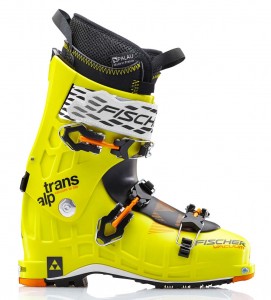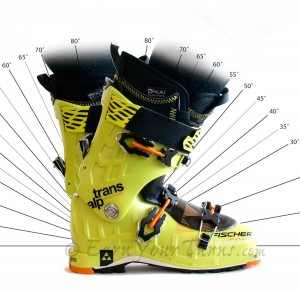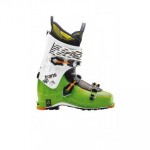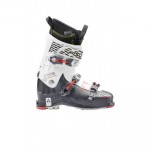TransAlp for Touring
There’s lots to like about Fischer’s Trans Alp. As you might expect, it has most of the features you would expect in a boot made with long tours in mind. For starters it comes with tech inserts for use with light weight, durable 2-pin tech bindings. The lugged soles provide good grip on slippery surfaces when you’re walking or scrambling with skis on your back, not underfoot.
It may not take the cake for being the lightest boot on the market, but at less than 3½ pounds per boot it certainly qualifies as a light, not a mid- or heavy weight boot.The cuff has great range of motion in tour mode, 18° back, 35° or more forward, with relatively little resistance to leg movement. Half that comes from the cuff allowing a lot of fore-aft movement, and half from a tongued Palau™ liner constructed to enhance movement, not restrict it. Although there is reinforcing plastic on the cuff of the liner, it isn’t thick, and is articulated to allow movement when the cuff shell is loose.
Fit Volume
Fitwise the TransAlp series tends to fit a lower volume foot than their Ranger series. In either case it is worth noting that the use of heat moldable Vacu-Plast shell material sort of renders dimensional numbers like last width moot since, at least for dealers with the Vacuum Molding System the shell can be stretched or shrunk up to 5mm in either direction. Unlike other boots with this shell molding option, like Salomon, the lower shell and cuff are both made with Vacu-plast, something those with bony ankles will appreciate. In terms of the width of the sole, the last width does define the starting point, and is a foundational dimension that can’t change, but the shell above it can be easily made wider, and to a lesser extent, shrunk, as your foot may desire. For the majority of feet, simply having a heat moldable Palau liner should accommodate fit issues for most feet.
Keep in mind molding Vacu-plast doesn’t require a Vacuum Molding System; in fact the shell material molds even easier and at lower temperatures than Pebax®, Grilamid®, or Polyurethane. However it takes longer (> 24 hrs.) to set. In the case where you need multiple punches Fischer’s vacuum molding process theoretically offers a faster, more precise solution, but conversely requires a shop with the expertise to do it well. Be aware this vacuum molding process is an art that is still evolving. As a general rule it works better for expanding than taking up volume.
Downhill Chops
All the aforementioned are solid pluses for Fischer’s TransAlp TS Lite. Where the boot comes up short is the control it offers in downhill mode. It isn’t strictly because it only offers three buckles, although that does give a quick indication of how much power it is capable of delivering. For contrast, consider Tecnica’s Cochise Pro 130; it appears to be a 3-buckle boot too, except it’s in a different league for stiffness and control. Indeed, part of the issue with the TransAlp is its overall softness, arguably around 115 for relative flex stiffness which isn’t unreasonably soft for ski touring. The real issue with the TransAlp? There simply isn’t enough cuff to be able drive a modern fat ski with power. Flex your leg forward and you will quickly realize, even with reinforcing pads on the liner cuff, the shell cuff is too short. That, unfortunately, is the fatal flaw in this boot.Conclusion
As all this suggests, Fischer’s TransAlp is a great boot for backcountry skiing where the emphasis is on taking long day tours. Woe to those who think it would be good for a traverse where you’re likely to be carrying a heavy pack, or for driving fat skis fatter than 105mm. For that you either need perfect corn conditions, a boot with a taller cuff, or impeccable technique in all conditions. Alternatively you could shed some of the fat in the planks you ride and the TransAlp would be all the boot you need.
Fischer
MSRP: $850
Weight/boot (sz. 26.5): 3 lbs., 7 oz. (1550 g)
Mens Sizes available: 23.5 – 30.5
Women’s Sizes available: 23.5 – 26.5
TransAlp TS
MSRP: $800
Weight/boot (sz. 26.5): 3 lbs., 10 oz. (1620 g)
Sizes available: 23.5 – 30.5
© 2014





6 pings